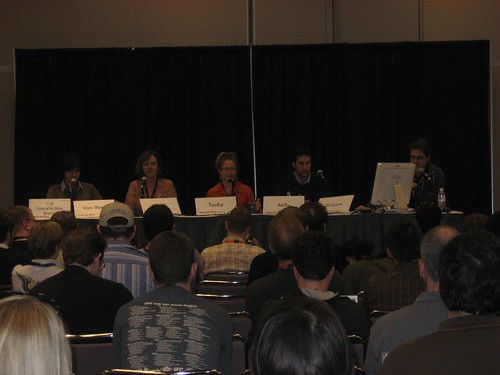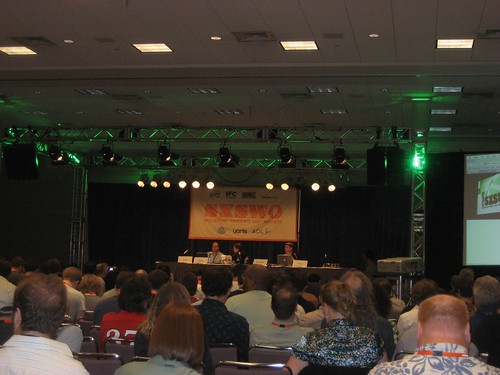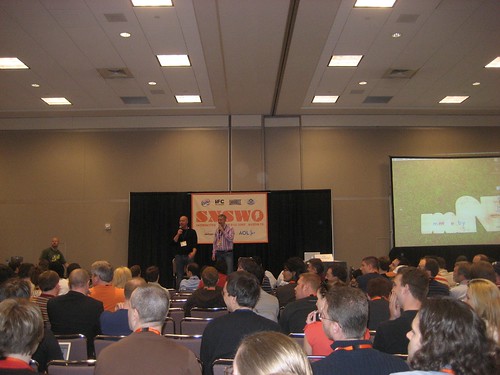1:30AM The Future of the Online Magazine (19AB)
Moderator: Rufus Griscom CEO, Nerve Media
Rufus Griscom CEO, Nerve Media
Sean Mills The Onion
Ricky Van Veen Editor, CollegeHumor.com
Laurel Touby CEO & Founder, mediabistro.com
Joan Walsh Editor in Chief, Salon.com

Rough Panel Notes
collective average age of their sites – 9.5 years. Online magazines have been around for a long time – are 1.0. How have they changed given user generated content?
web 2.0 has been good for salon – is edited content obsolete? Joan – of course not. Walter Reed hospital – Salong broke story, but blogosphere really exposed it to the mainstream media.
keep in mind that newsletters still reach more people than rss feeds.
Onion started as a newspaper – try to take advantage of all of the 2.0 stuff.
There’s no replacement for talented writers and editing. Something to be said for having a full time staff to cover the dick humor even on the weekends.
media bistro – 27 staff members and 7 bloggers
salon – 28 people in editorial, 60 total
college humor – 40 people, 9 full-time editorial
onion – 13 comedy writers, 18-20 editorial
nerve – 25 people
Premium paid content – open is important because of natural link traffic. Ad revenue is increasing. Paid content is on the way out. But advertising is cyclical, so we have to think about the paid models and be nimble. Membership is a way to form a loyal core – giving stuff away, etc.
Other ways to get revenue – merchandising. – Busted tees. Books are another way – not a huge revenue generator, but enough to be worth it.
Nerve – charge only for racier photography. Insulates advertisers for racier stuff. Babble – mag for urban parents. 10 bloggers all day long, video.
Advertising is biggest revenue – 80%
media bistro – job listings classes & seminars as revenue generators.
Salon – 50,000 subscribers.
college humor – all the offline is addtional, not part of initial model. – books, movie. Shirts helped at the beginning – 1/2 of revenue.
Moderation Policies of user generated content:
college humor – require an edu address, is it more angry than it is funny
salon – very light moderation, requiring an email authenticated address to get consistent handles. Right to pull things down for any reason. Editors choice picks to bump up good letters. user moderation to rate others letters.
nerve – sometimes writers object to comments.
salon – 9/11 angry readers wrote mean things. often the community will moderate things.
does user generated content interfere with consistent voice?
college humor – built on animal house tone from users, so it’s not a problem for them. helps to have 1-3 people to serve as moderators as voice and tone of site.
onion – level of discourse on comments has been shockingly good on a.v. club, so they’ve sometimes reached out to hire commenters. no comments on onion proper – a bit different because it’s satirical.
relationship between blogs and online magazines – do people come to homepage, or from links?
salon – 75 to home page
media bistro – much of traffic to job boards, many go straight to blogs
onion – getting traffic from links is growing and is what they desire – marketing for them.
Nerve – lots of traffic is on their blogs.
whitkey – css online magazines question: why not let user content on home page?
college humor – it will if it’s good
onion – organic process for discovering new writers, so they haven’t had to. editorial model is “you are dumb”
salon – surprisingly more unsolicited stuff gets used than someone would think. They do put user-generated content on the front page if it’s really good.
Nerve – more hybrid model will come in 5 or 10 years. Combination is particularly powerful – american idol example.
larry smith – contracts for content that becomes a book or other stuff –
onion – they have content for those types of projects.
salon – they have contract for that and reward people.
nerve – we have a similar contract
media – we have standard journalist contract.
what have you done that has failed?
onion – paid subscription model didn’t work well. 24 hour news cycle; they backed off of that so much.
salon – most of cuts were based on revenue and expense.
media – haven’t had the boom in LA for classes that they had in NY.
college humor – short form video has been a big experiment and some have been good and others not.
Blogs – how do you deal with bloggers having their own sites, contracts?
media bistro – it is a problem. sometimes with a full-time bloggers. Shouldn’t be producing work on the side.
Nerve – opposite philosophy – encourage them because they generate content from their own blogs.
salon – way too busy to have their own.
Do you have your own design staffs?
onion – yes they have their own staff 3 people – better for content.
nerve – 2 full time and 3 part time – design doesn’t scale, so you need them. also, good designers is hard to find.
college humor – finding a good designer is tough. They have them.
Format question – differences between a magazine and a website, flash, pdf?
Onion – only call them magazines when talking to advertisers. otherwise call them websites.
Salon – don’t agree with the word magazine.
media bistro – trying to ptu the the magazine format online is crazy because it doesn’t take advantage of the features of the web.
Nerve – coherently branded experience is evocative of “magazines.”
Onion has print component, do others have that idea?
Nerve – didn’t work regularly. Maybe quarterly.
Onion – why do we keep it? great way to get local advertising, still works as a business.
party – club deville 6:30-8:30 open bar.



